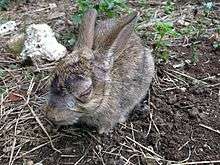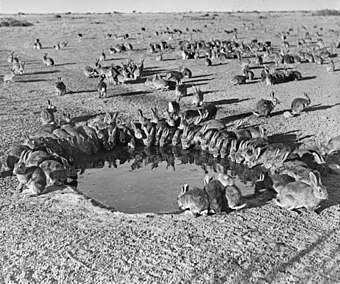Myxomatosis

Myxomatosis is a disease that affects rabbits, caused by the myxoma virus. It was first observed in Uruguay in laboratory rabbits in the late 19th century. It was introduced into Australia in 1950 in an attempt to control the rabbit population (see Rabbits in Australia). Affected rabbits develop skin tumors, and in some cases blindness, followed by fatigue and fever; they usually die within 14 days of contracting the disease.
The disease is spread by direct contact with an affected animal or by being bitten by fleas or mosquitoes that have fed on an infected rabbit. The myxomatosis virus does not replicate in these insect hosts, but can be physically carried by an insect's mouthparts, i.e. from an infected rabbit to another susceptible animal. Due to the potential of insect vector transmission, pet rabbits may be susceptible in enzootic areas and vaccination is highly recommended.[1]
Effects of the disease
.jpg)
In rabbits of the genus Sylvilagus (cottontail rabbits) living in the Americas, myxomatosis causes only localized skin tumors, but the European rabbit (Oryctolagus cuniculus) is more severely affected.[2] At first, normally the disease is visible by lumps (myxomata) and puffiness around the head and genitals. It may progress to acute conjunctivitis and possibly blindness; however, this also may be the first visible symptom of the disease. The rabbits become listless, lose appetite, and develop a fever. Secondary bacterial infections occur in most cases, which cause pneumonia and purulent inflammation of the lungs. In cases where the rabbit has little or no resistance, death may take place rapidly, often in as little as 48 hours; most cases result in death within 14 days.[3] Often the symptoms like blindness make the infected rabbit more vulnerable to predators.
Effects on other organisms
Rabbits helped keep vegetation in their environments short through grazing and short grasses are conducive to habitation by the butterfly, Plebejus argus[4]. When the population of rabbits experienced a decline due to Myxomatosis, grass lengths increased, limiting the environments in which P. argus could live, thereby contributing to the decline of the butterfly population.[4]
Treatment
In pet rabbits, myxomatosis can be misdiagnosed as pasteurellosis, a bacterial infection which can be treated with antibiotics.[5] By contrast, there is no treatment for rabbits suffering from myxomatosis, other than palliative care to ease the suffering of individual animals, and the treatment of secondary and opportunistic infections,[3] in the hopes the treated animal will survive. In practice, the owner is often urged to euthanize the animal to end its suffering.
Use as a population control agent

After its discovery in 1896 in imported rabbits in Uruguay, a relatively harmless strain of the disease spread quickly throughout the wild rabbit populations in South America.
Australia
In Australia, the virus was first field-tested for population control in 1938. A full-scale release was performed in 1950. It was devastatingly effective, reducing the estimated rabbit population from 600 million to 100 million in two years. However, the rabbits remaining alive were those least affected by the disease. Genetic resistance to myxomatosis was observed soon after the first release, and descendants of the survivors acquired partial immunity in the first two decades. Resistance has been increasing slowly since the 1970s; the disease now kills about 50% of infected rabbits. In an attempt to increase that rate, a second virus (rabbit calicivirus) was introduced into the rabbit population in 1996.
France
Myxomatosis was introduced to France by the bacteriologist Dr. Paul Armand Delille, following his use of the virus to rid his private estate of rabbits in June 1952 (He inoculated two of the rabbits on his land).[6] Within four months the virus had spread 50 km; Armand suspected this was due to poachers taking infected rabbits from his estate. By 1954, 90% of the wild rabbits in France were dead. The disease spread throughout Europe.
Ireland
Myxomatosis was deliberately introduced to Ireland by farmers in 1954.[7][8][9] The skin of a diseased rabbit was sent by post from the United Kingdom and rubbed on healthy rabbits.[7] Infected animals were transported around the country to hasten the spread of the disease.[7] By 1955, myxomatosis had spread to every part of Ireland and, by the 1960s, the rabbit meat industry had collapsed.[9]
United Kingdom
The disease reached the UK in 1953. The first outbreak in the UK to be officially confirmed was in Bough Beech, Kent in September 1953.[10] It was encouraged in the UK as an effective rabbit bio-control measure; this was done by placing sick rabbits in burrows, though this is now illegal in the UK under a 1954 law.[11] As a result, it is understood that more than 99% of rabbits in the UK were killed by the outbreak, although populations soon recovered.[12]
New Zealand
Myxomatosis was introduced in New Zealand in the early 1950s as a form of pathogenic control. Unlike in Australia, it failed to become established because of a lack of a suitable spreading organism.
Use of vaccine
A vaccine is available for pet rabbits (ATCvet code: QI08AD02 (WHO)).[1] The vaccine is not allowed to be used in Australia because the live virus in the vaccine has the potential to spread into the wild rabbit population which could result in wild rabbit immunity to myxomatosis.[13] If this happened, there would be a dramatic increase in the number of wild rabbits in Australia, which would cause major damage to the environment and economic losses.[13] Many pet rabbits in Australia continue to die from the disease due to their lack of immunity.[14][15] There is at least one campaign to allow the vaccine for domestic pets.[16]
In the UK a live combination vaccine, Nobivac Myxo-RHD, made by MSD Animal Health, has become available since 2011.[17] Its active ingredient is a live myxoma-vectored RHD virus strain 009 and it offers a duration of immunity of 1 year against both RHD and myxomatosis.[18]
Natural resistance
The development of resistance to the disease has taken different courses. In Australia, the virus initially killed rabbits very quickly – about 4 days after infection. This gave little time for the infection to spread. However, a less virulent form of the virus then became prevalent there, which spread more effectively by being less lethal. In Europe, many rabbits are genetically resistant to the original virus that was spread. The survival rate of diseased rabbits has now increased to 35%, while in the 1950s it was near zero.[19]
On 13 October 2018, it was confirmed that myxomatosis has jumped to hares.[20]
References
- 1 2 Dykes, Linda; Brown, Judith (2000). "Understanding Myxomatosis". Rabbit Welfare Association & Fund. Retrieved 17 July 2011.
- ↑ Carter, G.R.; Wise, D.J. (2006). "Poxviridae". A Concise Review of Veterinary Virology. Retrieved 13 June 2006.
- 1 2 "Myxomatosis in Rabbits". Exoticpets.about.com. 14 December 2009. Retrieved 3 June 2010.
- 1 2 Ravenscroft, N. O. M. (1990-01-01). "The ecology and conservation of the silver-studded blue butterfly Plebejus argus L. on the sandlings of East Anglia, England". Biological Conservation. 53 (1): 21–36. doi:10.1016/0006-3207(90)90060-3.
- ↑ "Pasteurellosis". Long Beach Animal Hospital. Retrieved 17 July 2011.
- ↑ The Private Life of the Rabbit by R. M. Lockley (Andre Deutsch, London 1964)
- 1 2 3 Conry, Michael J. (2016). The Rabbit Industry in Ireland: 20th Century Snapshots. Conry Books.
- ↑ Viney, Michael (7 January 2017). "A furry good history of the wild Irish rabbit". The Irish Times. Dublin. Retrieved 15 October 2017.
- 1 2 Cadogan, Stephen (23 March 2017). "How a thriving food industry faded away to nothing in the 1960s". The Irish Examiner. Cork. Retrieved 15 October 2017.
- ↑ Bartrip, Peter (2008). Myxomatosis: A History of Pest Control and the Rabbit. Google ebook.
- ↑ "Section 12, Pests Act 1954". Legislation.gov. Retrieved 18 December 2014.
- ↑ Parkinson, Justin (9 April 2016). "How buzzards came to fly over the UK again". BBC News magazine. Retrieved 2016-04-09.
- 1 2 "Information on myxomatosis vaccine availability in Australia" (PDF). Department of Agriculture, Fisheries and Forestry. Archived from the original (PDF) on 2 September 2012. Retrieved 3 October 2012.
- ↑ "About Us (Losses at The Rabbit Sanctuary to Myxomatosis)". Myxomatosis Hotline. The Rabbit Sanctuary. Retrieved 17 July 2011.
- ↑ "A Statement from the Chief Veterinary Officer (Australia) on myxomatosis vaccine availability in Australia". Australian Department of Agriculture, Fisheries and Forestry. 15 April 2011. Retrieved 17 July 2011.
- ↑ "The Campaign: Send a Rabbit to Canberra!". Myxomatosis Hotline. The Rabbit Sanctuary. Retrieved 17 July 2011.
- ↑ "Nobivac Myxo-RHD" (PDF). European Commission. Retrieved 7 September 2011.
- ↑ "National Office of Animal Health rabbit vaccines". Noahcompendium.co.uk. Archived from the original on 26 May 2013. Retrieved 12 August 2013.
- ↑ UK National Archives File TNA MAF 168/14. Ministry of Agriculture veterinarians tested 27 surviving rabbits behind the front of the 1953 Bough Beech outbreak area and found only one with the antibodies for the disease.
- ↑ "Hares could be wiped out, experts warn, as mystery deaths spark fears RHD-2 has 'jumped' from rabbits". The Telegraph.
Further references
- Deane, C.D. 1955. Note on myxomatosis in hares. Bulletin of the Mammal Society of the British Isles. 3: 20.
External links
| Wikimedia Commons has media related to Myxomatosis. |